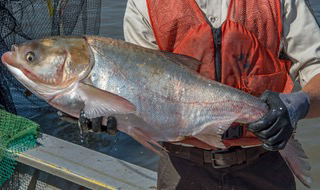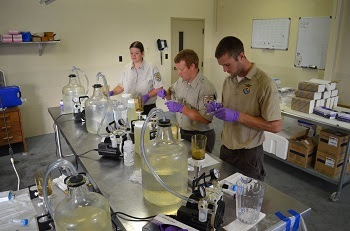Silver carp environmental DNA detected in Lake Michigan tributary
The Michigan Department of Natural Resources (MDNR) and U.S. Fish and Wildlife Service (USFWS) are collaborating to assess a recent positive environmental DNA (eDNA) result for silver carp – a species of Asian carp — within the lower Kalamazoo River, Allegan County, Michigan.
Two hundred water samples were taken in July 2014 along the Kalamazoo, from below the Caulkins Dam in Allegan County to the mouth of the river. Laboratory results, which take several months to process, were reviewed by the DNR Oct. 2. One of the of 200 samples tested positive for silver carp eDNA. The positive sample was taken from just below the Caulkins Dam.
An additional 200 eDNA samples were collected in the same vicinity in June and resulted in no positive results. The July sample represents the first time that Michigan has experienced a positive result for silver carp eDNA in Michigan’s Great Lakes waters outside of Maumee Bay.
The findings indicate the presence of genetic material of silver carp, such as scales, excrement or mucous. However, there is no evidence that a population of silver carp is established in the Kalamazoo River. In addition to live fish, genetic material can enter water bodies via boats, fishing gear and the droppings of fish-eating birds. The lower Kalamazoo River is popular for recreational activities including fishing and boating. Activities such as these may increase the possibility of eDNA entering the river without the presence of a live silver carp.
“Although not conclusive, this finding heightens our vigilance and sets into motion a specific response,” said MDNR Director Keith Creagh. “We will work with our partner organizations and anglers on next steps to protect the Great Lakes and its tributaries against this significant threat.”
In response to the finding, the MDNR:
- Requested last Friday additional assistance from the USFWS to implement a third eDNA surveillance effort on the lower Kalamazoo River. The collection of an additional 200 samples begins today. Analysis of the samples will be expedited and results should be available within a month.
- Will increase the presence of MDNR staff along the Kalamazoo River to enlist anglers to report any Asian carp sightings.
- Will place information in local bait shops to broaden public awareness.
“At the state’s request, the U.S. Fish and Wildlife Service is providing all the resources and technical expertise we have available,” said U.S. Fish and Wildlife Service Deputy Regional Director Charlie Wooley. “The Service is committed to working in a coordinated, landscape-level, approach to prevent the establishment of self-sustaining populations of Asian carp in the Great Lakes.”
The results from this third round of sampling will inform and guide any future assessment and response actions for silver carp in the Kalamazoo River. “We appreciate the assistance and technical expertise that the USFWS brings to the table in the development and implementation of a comprehensive eDNA surveillance plan to further evaluate the Kalamazoo River,” said Creagh. “We have well-established and practiced protocols for addressing eDNA results. Our coordinated efforts represent an important and prudent response to this detection.”
MDNR has put significant effort toward assessing the fish populations of the Kalamazoo River with specialized gear that is capable of capturing carp. The MDNR has received no reports from anglers in this area that indicate the presence of live Asian carp.
In preparation for response to findings of bighead, silver or black carp in Michigan’s waters of the Great Lakes and tributaries, MDNR has conducted field and tabletop response exercises to prepare for a possible invasion of Asian carp species such as silver carp. Field exercises, funded through the Great Lakes Restoration Initiative, were conducted in the St. Joseph River in 2013 and the Western Basin of Lake Erie in September 2014. In addition to these exercises, nearly 1,800 eDNA water samples have been collected this year from Great Lakes tributaries in southwest and southeast Michigan.
With implementation of the recently signed Council of Great Lakes Governors’ Aquatic Invasive Species Mutual Aid Agreement, the response exercises brought together staff from other Great Lakes state and federal agencies, including Canada and Ontario, to test response scenarios and various equipment and gear used to capture Asian carp species.
Michigan has a comprehensive Asian Carps Management Plan to guide prevention, early detection and management responses. In addition, the state has recently launched a comprehensive invasive species effort to address threats to Michigan’s waters and land.
Asian carp, including bighead and silver carp, pose a significant threat to the Great Lakes ecosystem, the $7 billion fishery, and other economic interests dependent on the Great Lakes and its tributaries. Silver and bighead carp are likely to compete with native and recreational fish species and are known to quickly reproduce.
“The Kalamazoo River results further point to the urgency of the Great Lakes states to be vigilant in seeking all solutions to keep Asian carp and other invasive species out of the Great Lakes basin,” said Creagh. “Michigan continues to advocate for hydrological separation between the Mississippi River basin and the Great Lakes basin as the best long-term solution to the threat of Asian carp. By working together as a united front, we can address the imminent threat invasive species pose to our quality of life.”
Anglers and boaters are vital stewards to prevent movement of Asian carp and other invasive species that threaten Michigan’s waters. Anglers are urged to become familiar with the identification of Asian carp, including both adults and juveniles, as the spread of juvenile Asian carp through the use of live bait buckets has been identified as a potential point of entry into Great Lakes waters. Anglers and boaters are strongly encouraged to drain all water from their boats and to clean boats and gear. Invasive species and eDNA are known to “hitchhike” within live-wells and attach to boat trailers, anchors and fishing gear.
A video demonstrating how to identify bighead and silver carp can be viewed on the USFWS YouTube channel at http://youtu.be/B49OWrCRs38?source=govdelivery. A video focused on identification of juvenile Asian carp species can be viewed at http://www.michigan.gov/dnr/0,4570,7-153–317128–s,00.html. Identification guides, frequently asked questions, management plans and an online reporting form for Asian carp sightings are available online at michigan.gov/asiancarp.
More information on eDNA is available here: http://www.asiancarp.us/edna.htm. Results of eDNA monitoring from the Midwest region are posted here: http://www.fws.gov/midwest/fisheries/eDNA.html.
The mission of the USFWS is working with others to conserve, protect and enhance fish, wildlife, plants and their habitats for the continuing benefit of the American people.





